Publications
A Shrink Wrapping Approach to Remeshing Polygonal Surfaces
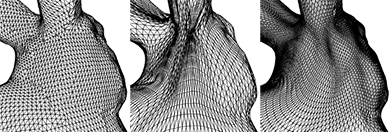
Due to their simplicity and flexibility, polygonal meshes are about to become the standard representation for surface geometry in computer graphics applications. Some algorithms in the context of multiresolution representation and modeling can be performed much more efficiently and robustly if the underlying surface tesselations have the special subdivision connectivity. In this paper, we propose a new algorithm for converting a given unstructured triangle mesh into one having subdivision connectivity. The basic idea is to simulate the shrink wrapping process by adapting the deformable surface technique known from image processing. The resulting algorithm generates subdivision connectivity meshes whose base meshes only have a very small number of triangles. The iterative optimization process that distributes the mesh vertices over the given surface geometry guarantees low local distortion of the triangular faces. We show several examples and applications including the progressive transmission of subdivision surfaces.
Discrete fairing of curves and surfaces based on linear curvature distribution
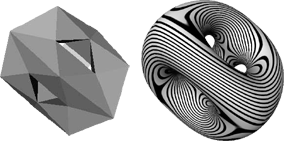
In the planar case, one possibility to create a high quality curve that interpolates a given set of points is to use a clothoid spline, which is a curvature continuous curve with linear curvature segments. In the first part of the paper we develop an efficient fairing algorithm that calculates the discrete analogon of a closed clothoid spline. In the second part we show how this discrete linear curvature concept can be extended to create a fairing scheme for the construction of a triangle mesh that interpolates the vertices of a given closed polyhedron of arbitrary topology.
Multiresolution Hierarchies on Unstructured Triangle Meshes
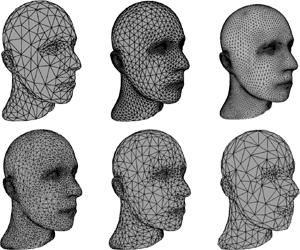
The use of polygonal meshes for the representation of highly complex geometric objects has become the de facto standard in most computer graphics applications. Especially triangle meshes are preferred due to their algorithmic simplicity, numerical robustness, and efficient display. The possibility to decompose a given triangle mesh into a hierarchy of differently detailed approximations enables sophisticated modeling operations like the modification of the global shape under preservation of the detail features. So far, multiresolution hierarchies have been proposed mainly for meshes with subdivision connectivity. This type of connectivity results from iteratively applying a uniform split operator to an initially given coarse base mesh. In this paper we demonstrate how a similar hierarchical structure can be derived for arbitrary meshes with no restrictions on the connectivity. Since smooth (subdivision) basis functions are no longer available in this generalized context, we use constrained energy minimization to associate smooth geometry with coarse levels of detail. As the energy minimization requires one to solve a global sparse system, we investigate the effect of various parameters and boundary conditions in order to optimize the performance of iterative solving algorithms. Another crucial ingredient for an effective multiresolution decomposition of unstructured meshes is the flexible representation of detail information. We discuss several approaches.
Robust Multi-Band Detail Encoding for Triangular Meshes of Arbitrary Connectivity
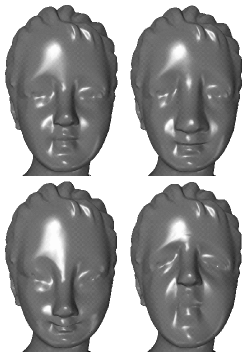
The flexibility coming along with the simplicity of their base primitive and the support by todays graphics hardware, have made triangular meshes more and more popular for representing complex 3D objects. Due to the complexity of realistic datasets, a considerable amount of work has been spent during the last years to provide means for the modification of a given mesh by intuitive metaphors, i.e. large scale edits under preservation of the detail features. In this paper we demonstrate how a hierarchical structure of a mesh can be derived for arbitrary meshes to enable intuitive modifications without restrictions on the underlying connectivity, known from existing subdivision approaches. We combine mesh reduction algorithms and constrained energy minimization to decompose the given mesh into several frequency bands. Therefore, a new stabilizing technique to encode the geometric difference between the levels will be presented.
Approximation and Visualization of Discrete Curvature on Triangulated Surfaces
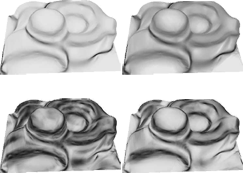
Triangle meshes are a facile and effective representation for many kinds of surfaces. In order to rate the quality of a surface, the calculation of geometric curvatures as there are defined for smooth surfaces is useful an necessary for a variety of applications. We investigate an approach to locally approximate the first and second fundamental forms at every (inner) vertex of a triangle mesh. We use locally isometric divided difference operators, where we compare two variants of parameterizations (tangent plane and exponential map) by testing on elementary analytic surfaces. We further describe a technique for visualizing the resulting curvature data. A simple median filter is used to effectively filter noise from the input data. According to application dependent requirements a global or a pervertex local color coding can be provided. The user may interactively modify the color transfer function, enabling him or her to visually evaluate the quality of triangulated surfaces.
Real-time Exploration of Regular Volume Data by Adaptive Reconstruction of Iso-Surfaces

We propose an adaptive approach for the fast reconstruction of isosurfaces from regular volume data at arbitrary levels of detail. The algorithm has been designed to enable real-time navigation through complex structures while providing user-adjustable resolution levels. Since adaptive on-the-fly reconstruction and rendering is performed from a hierarchical octree representation of the volume data, the method does not depend on preprocessing with respect to a specific isovalue, thus the user can browse interactively through the set of all possible isosurfaces. Special attention is paid to the fixing of cracks in the surface where the adaptive reconstruction level changes and to the efficient estimation of the isosurface's curvature.
Previous Year (1998)

